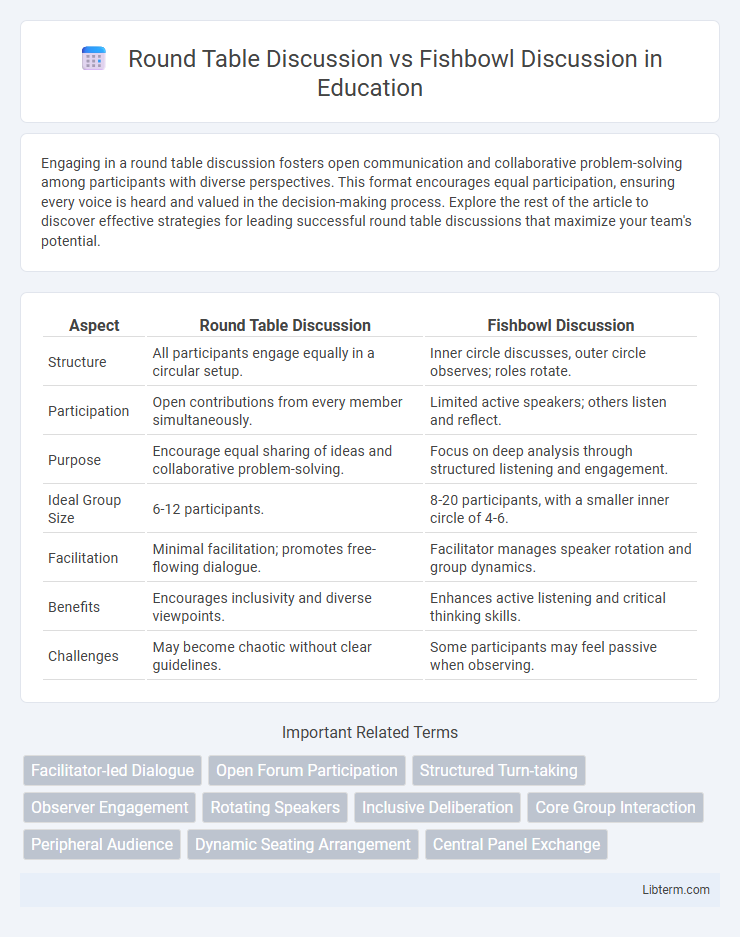Engaging in a round table discussion fosters open communication and collaborative problem-solving among participants with diverse perspectives. This format encourages equal participation, ensuring every voice is heard and valued in the decision-making process. Explore the rest of the article to discover effective strategies for leading successful round table discussions that maximize your team's potential.
Table of Comparison
| Aspect | Round Table Discussion | Fishbowl Discussion |
|---|---|---|
| Structure | All participants engage equally in a circular setup. | Inner circle discusses, outer circle observes; roles rotate. |
| Participation | Open contributions from every member simultaneously. | Limited active speakers; others listen and reflect. |
| Purpose | Encourage equal sharing of ideas and collaborative problem-solving. | Focus on deep analysis through structured listening and engagement. |
| Ideal Group Size | 6-12 participants. | 8-20 participants, with a smaller inner circle of 4-6. |
| Facilitation | Minimal facilitation; promotes free-flowing dialogue. | Facilitator manages speaker rotation and group dynamics. |
| Benefits | Encourages inclusivity and diverse viewpoints. | Enhances active listening and critical thinking skills. |
| Challenges | May become chaotic without clear guidelines. | Some participants may feel passive when observing. |
Introduction to Discussion Formats
Round Table Discussion features equal participation from all attendees seated around a table, promoting open dialogue without a fixed hierarchy. Fishbowl Discussion involves an inner circle of active speakers surrounded by an outer circle of observers, allowing dynamic interaction while maintaining structured observation. These formats differ primarily in interaction style, participant engagement, and spatial arrangement, influencing conversation flow and inclusivity.
Defining Round Table Discussions
Round Table Discussions involve a small group of participants seated evenly to encourage equal participation and open dialogue, typically focusing on collaborative problem-solving or decision-making. This format emphasizes direct interaction, collective input, and consensus-building among all members present. Unlike Fishbowl Discussions, which use an inner and outer circle to manage participation, Round Tables promote continuous engagement from everyone without structured speaking roles.
Understanding Fishbowl Discussions
Fishbowl discussions center on a small group of participants actively engaging while others observe, promoting deep listening and dynamic exchanges. Unlike round table discussions where every participant voices opinions equally, fishbowls emphasize rotating roles between speakers and listeners to foster empathy and nuanced understanding. This format enhances focus on core ideas by minimizing cross-talk and encouraging reflective dialogue among observers and contributors.
Key Differences Between Round Table and Fishbowl
Round Table Discussion features equal participation from all members seated in a circular arrangement, emphasizing collaborative dialogue and shared decision-making. Fishbowl Discussion involves an inner circle of active speakers surrounded by an outer circle of listeners, promoting focused exchanges and allowing observers to join the conversation by replacing participants. The key differences lie in participant engagement, structure, and the level of interaction, with Round Table encouraging inclusive dialogue and Fishbowl facilitating dynamic speaker rotation and audience involvement.
Advantages of Round Table Discussions
Round Table Discussions promote equal participation and foster open dialogue by positioning all participants on an equal footing, eliminating hierarchical barriers. They encourage diverse perspectives and collaborative problem-solving through direct interaction among all members. This format enhances engagement and inclusivity, leading to more comprehensive insights and collective decision-making.
Benefits of Fishbowl Discussions
Fishbowl discussions promote active listening and inclusivity by allowing a dynamic rotation of participants from the outer circle to the inner circle, fostering diverse perspectives. This format enhances engagement and deeper understanding of complex topics by encouraging open dialogue and continuous participation. Fishbowl discussions also improve group cohesion and decision-making efficiency by creating a transparent and structured environment for sharing ideas.
Use Cases for Round Table Format
Round Table Discussions excel in collaborative environments where equal participation and diverse perspectives drive decision-making, such as strategic planning sessions or team problem-solving workshops. Their format encourages open dialogue and balanced contribution from all participants, making them ideal for organizational meetings, academic seminars, or policy development forums. Unlike Fishbowl Discussions, which are suited for observing group dynamics and audience engagement, Round Tables foster direct interaction and consensus-building among all attendees.
Situations Best Suited for Fishbowl Format
The Fishbowl Discussion format is best suited for large group settings where active participation from many attendees is encouraged while maintaining focused dialogue. It works well in scenarios involving complex topics requiring diverse perspectives or when facilitators aim to foster inclusivity and balanced contribution. Situations like community forums, educational seminars, and organizational strategy meetings benefit from the Fishbowl approach to enhance engagement and transparency.
Choosing the Right Discussion Method
Selecting the appropriate discussion method depends on group size, interaction goals, and topic complexity. Round Table Discussions foster equal participation and open dialogue among small to medium groups, enhancing diverse viewpoints. Fishbowl Discussions suit larger groups by allowing focused inner-circle conversations with outer-circle observers, promoting deeper insight and structured engagement.
Maximizing Engagement in Group Discussions
Round Table Discussions foster equal participation by seating all members in a circle, encouraging direct dialogue and balanced contributions. Fishbowl Discussions maximize engagement by placing a small inner circle of active speakers surrounded by an outer circle of listeners, allowing dynamic shifts between observers and participants. Both formats enhance group interaction, with round tables promoting inclusive conversation and fishbowls stimulating focused, rotating engagement.
Round Table Discussion Infographic

 libterm.com
libterm.com